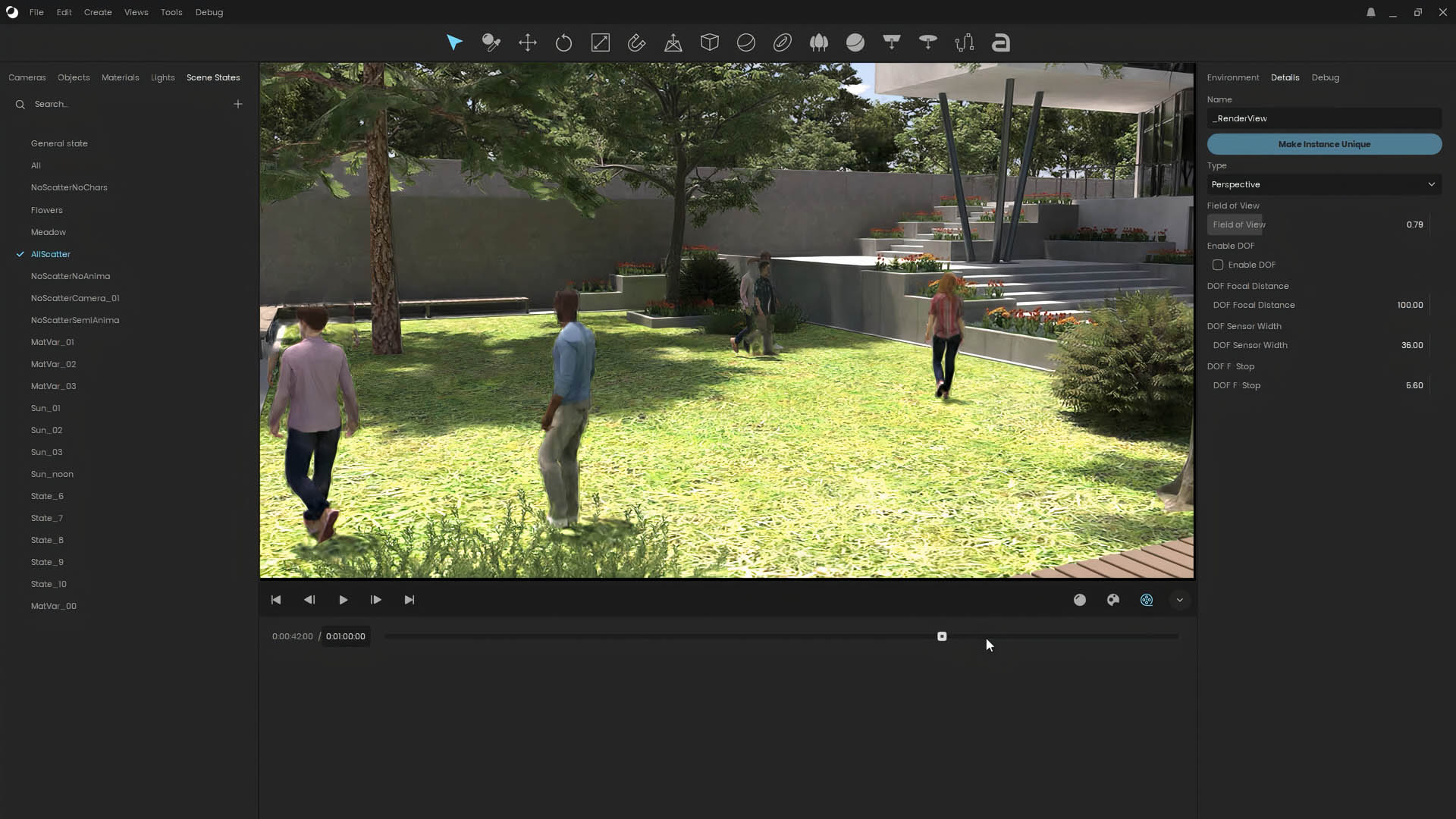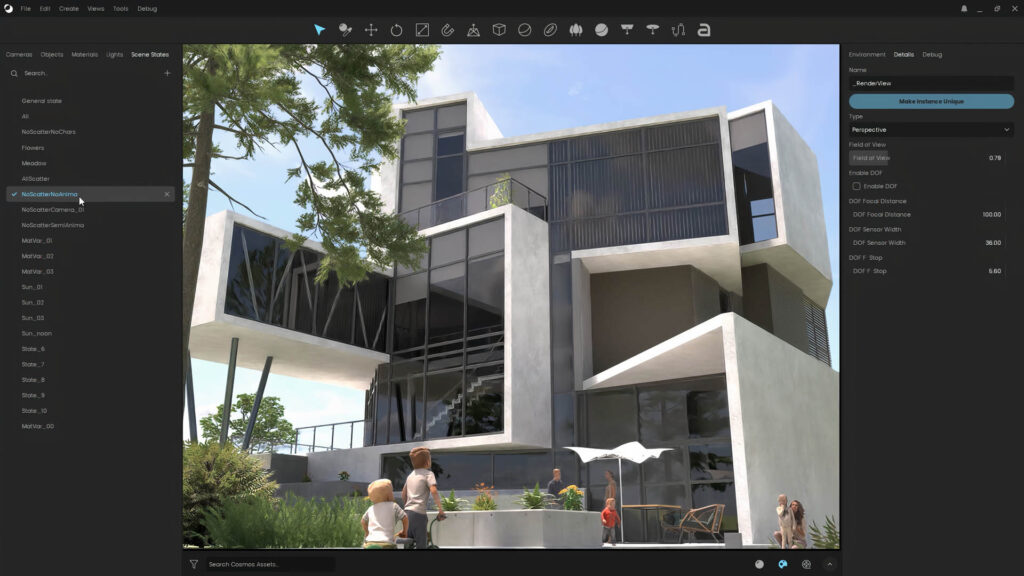Greg Corke caught up with Chaos to learn more about its plans for enhancing workflows between Enscape and V-Ray, embracing real time collaboration, and giving architects powerful new story-telling tools through Project Eclipse.
Two years ago, Chaos, the developer of V-Ray, merged with Enscape to create a single entity to cover all aspects of visualisation from real time to photorealism.
V-Ray and Enscape remain entirely separate products, with extremely passionate sets of users. The message is still clear: Enscape is for design decisions while V-Ray is for the highest tier of visual quality.
One of the key aims for the new look Chaos was to bring both applications closer together, to deliver a seamless end-to-end workflow for architectural visualisation.
Autumn 2022 delivered the first fruits of this integration, with a bridge between Enscape and V-Ray. The idea is that users can work in the best tool for the job without having to recreate each asset from scratch.
Within a single BIM environment, users could start in Enscape and then render in V-Ray at the click of a button with materials mapped accordingly. Then at the tail end of 2023, a V-Ray Scene (.vrscene) could be exported from Enscape so a viz artist could instantly pick up in a tool like 3ds Max, where an architect left off in Revit.
Petr Mitev, vice president, solutions for designers at Chaos, admits that this is just the beginning. The workflow can still be improved in many ways. One way is to add bi-directionality, as he explains, “If you’re iterating throughout the design process, it could be that the 3D artist makes more progress and then the architect has to then reconcile that.”
Drawing from his personal experience as an architect, Mitev explains how a viz artist might add additional lights in V-Ray because interior renderings benefit greatly from being well lit. The problem is, he says, is that once you’ve shown the client that rendered space and they like it, the architect now has to bring that same lighting back into Enscape.
Find this article plus many more in the March / April 2024 Edition of AEC Magazine
👉 Subscribe FREE here 👈
Another way to improve the workflow, is through what Mitev describes as ‘quality of life’ improvements. For example, sometimes a VRayScene export is too large or sometimes a certain asset or material doesn’t translate correctly. “We want to improve the handling of specific Enscape materials,” he says. “If you’ve ever seen our grass or our water, sometimes when users make the switch to V-Ray in that connection, they’re kind of surprised that it looks different.”
While better translation will help in the short term, the longer-term goal is to serve up all materials – for Enscape and V-Ray – through the Chaos Cosmos content library.
“We want to get into a pattern where a certain model or a certain texture, whatever it might be, has different levels of detail,” says Mitev. “So, if you’re in Enscape, and you have this material, which is suitable for Enscape [real time] performance, but the moment you want to take it to V-Ray, then Cosmos can deliver a much higher resolution thing [asset].”
Embracing collaboration
Like most real time visualisation tools, Enscape is well known for being GPU hungry. To deliver a fluid real time experience it requires a powerful graphics card, especially at high-resolutions and with enhanced realism, including ray tracing.
Of course, not everyone has access to a high-end GPU, so this limits the reach of Enscape’s real-time rendering, both within an architectural practice and with other stakeholders, including clients.
Enscape is addressing this on two fronts: one by optimising rendering so it is accessible on lower powered devices and two by using pixel streaming, where the graphics processing is done on a local server or in the Chaos Cloud using high-performance GPUs for the best visual quality and interactive experience.
Of course, driving this development is a greater need for collaboration. As Kam Star, chief product officer at Chaos, explains, it’s becoming increasingly important to experience the scene in real time with others.
“The real value here is collaborative design review, and to be able to do it in a way that brings everybody together, whether you’re the client or the engineer or the architect, or even construction personnel on site,” he says.
“Being able to mark up, being able to handhold somebody, walk them through something, capture comments based on a particular location or a particular view and be able to converse around that.”
Chaos currently has some collaborative tools within the Chaos software suite. Chaos Cloud Collaboration, which comes from the V-Ray side of the business, allows teams to upload and mark up images and panoramas. As Star explains, that will provide the foundation for real time collaboration in Enscape.
“[Chaos Cloud Collaboration] already has all of the kind of tools that you need in order to set who the team is, what kind of access they’ve got, tracking, all those kinds of things. We’re leveraging that in our streaming solution, but also within Enscape over the course of the year.”
Mitev adds that the next stage of development is to hook up the collaborative annotation feature to Enscape and make it sync bi-directionally to Chaos Cloud. “Chaos Cloud can really become our collaborative platform, whether it’s 2D or whether it’s 3D, it doesn’t matter, but that should be the single point of truth,” he says.
In recent years, VR has proven to be a very powerful platform for design review. We asked Chaos if its plans for collaboration in Enscape will extend to immersive environments? “That’s the direction,” says Star. “With VR we recognise that some of the interfaces will be slightly different to what we’ve got right now – because you need them to be different. But the model we’re building, internally, we call it build once, use everywhere.
“If the customer has created something, they should be able to experience it on any device and be able to interact with it, without having to worry too much about, ‘oh no, I’m on Windows or Mac now. Oh no, I only have my Android tablet today or Apple Vision Pro’. It’s just about being able to use and interact with things without [hardware] getting in the way.”
Story time
Chaos is working on a new ‘story-telling’ solution, codenamed Project Eclipse, that will allow architects and visualisers to ‘rapidly enhance’ scenes started in Enscape or V-Ray.
The standalone tool is designed to work seamlessly with exports from all Chaos rendering integrations and is fully compatible with the Chaos Cosmos content library.
Star describes Project Eclipse as a fully ray traced 3D assembly and animation application. “It’s aimed at architectural visualisers who want an easy tool to create really beautiful photorealistic animations,” he says, adding that you can enhance scenes with crowds, vehicles, traffic, and custom behaviours.


The software can also be used to present multiple design options to clients. “Here’s this option, and here’s that option, and let’s walk around it in real time,” he says. “Can I see it if the wall is here or there? Can I see it if the kitchen is moved? Can I see it at night? Can I see it with this colour, or can I see it with this material? You set up different options. You can set up the different views and you can then transition between them.”
Star points out that Project Eclipse supports workflows unlike those of competitive products, insofar as it preserves the visualisation effort that’s done in the 3D creation tool. “
It combines the exports from anywhere Enscape or V-Ray resides, preserving the work done with them – so what you see in Enscape or V-Ray where you create is what you get in Eclipse,” he says. “It gives you the ability to assemble scenes from multiple tools,” adding that it will soon support neutral exchange formats such as OBJ, FBX, DAE and 3DS and eventually USD and MaterialX.
One of the aims of Project Eclipse is to enable architects to do the type of work that previously would have to be done by a visualisation specialist in a DCC application like Autodesk 3ds Max or a real time tool like Unreal Engine.
“You don’t need to redo your materials. You don’t need to break the link between, let’s say, Revit or SketchUp or Rhino. You continue to work in the way that you want, and these things are kept in sync. It’s really just simplifying the workflow. You don’t have to go and redo anything if you did it once, you create an option for ‘A’, then an option for ‘B’,” he says.
Project Eclipse is an internal code name. The as-yet unnamed product will launch later this year.








